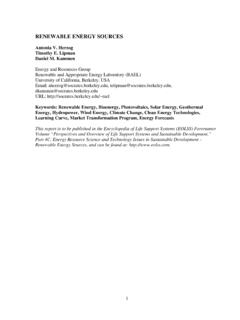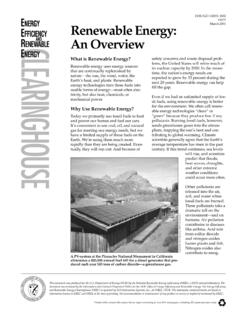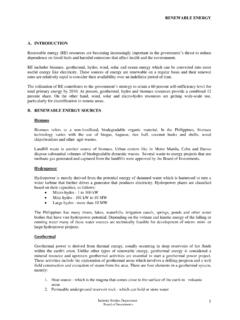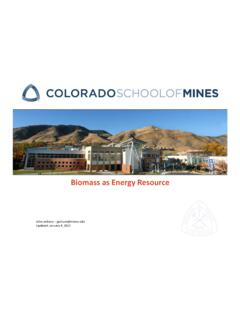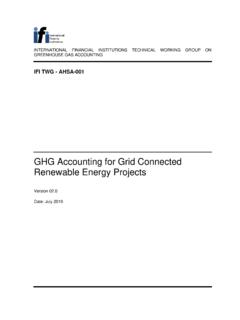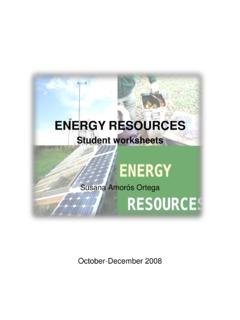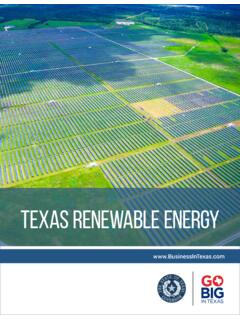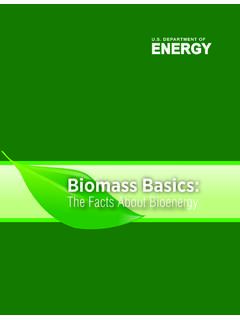Transcription of Biomass policy statement - assets.publishing.service.gov.uk
1 November 2021 Biomass policy statement Crown copyright 2021 This publication is licensed under the terms of the Open Government Licence except where otherwise stated. To view this licence, visit or write to the Information policy Team, The National Archives, Kew, London TW9 4DU, or email: Where we have identified any third-party copyright information you will need to obtain permission from the copyright holders concerned. Any enquiries regarding this publication should be sent to us at: Biomass policy statement 3 Contents About this document _____ 5 Executive Summary _____ 5 Scope _____ 6 Geographic extent _____ 7 Structure of this document _____ 8 Chapter 1: Biomass Feedstocks _____ 9 Sustainable Biomass _____ 10 Understanding the sustainable Biomass supply _____ 11 Feedstock availability to support future Biomass use _____ 12 Biogenic wastes and residues _____ 12 Domestic arable crops _____ 14 Perennial energy crops and short rotation forestry _____ 15 UK-derived forest products _____ 16 Marine-based and other novel feedstocks _____ 18 Chapter 2.
2 Biomass use in a low carbon economy _____ 19 Air Quality _____ 19 Priority use framework _____ 20 Electricity _____ 21 Heat _____ 23 Domestic and Non-Domestic Renewable Heat Incentives _____ 25 Boiler Upgrade Scheme _____ 25 Off-gas grid regulations _____ 26 Biomethane Green Gas Support Scheme _____ 26 Transport _____ 28 Renewable Transport Fuel Obligation _____ 28 Advanced Biofuel Demonstration Competitions _____ 29 Sustainable Aviation Fuel _____ 29 Industry sector _____ 30 Biomass as an energy source in the industry sector _____ 30 Industrial use of Biomass in chemicals, materials and construction sectors _____ 31 Biomass policy statement 4 Hydrogen _____ 33 Bioenergy with Carbon Capture and Storage (BECCS) _____ 34 Routes to BECCS _____ 36 Chapter 3: Research and Innovation _____ 40 Key research and innovation needs _____ 40 Creating a sustainable Biomass supply _____ 41 Innovation in routes for BECCS _____ 41 Air quality impacts _____ 42 Biomass in non- energy sectors _____ 43 Summary _____ 43 Chapter 4: Next Steps _____ 44 Biomass policy statement 5 About this document Executive Summary The Government is developing an ambitious plan to accelerate the decarbonisation of the economy across all sectors.
3 The Net Zero Strategy has set out the actions we will take to deliver on the UK s carbon budgets and 2030 Nationally Determined Contribution (NDC) and sets out our vision for a decarbonised economy in 2050. Central to achieving net zero by 2050 will be a transition to wide-scale deployment of low carbon technologies across all sectors of the economy, as well as a transition to low carbon ways of living and operating by individuals and businesses. The Net Zero Strategy set out that achieving net zero involves a move away from fossil fuels and growth in low carbon fuels, such as hydrogen, improving energy and resource efficiency, reducing demand for energy and carbon-intensive resources, delivering greenhouse gas removals (GGRs) at scale, and changing the way we use our land to support carbon sequestration and clean energy production among other things. Biomass has a role to play in all of these areas and is a vital resource for the key green technologies and energy carriers highlighted as necessary for net zero: low carbon electricity, hydrogen, carbon capture, and bioenergy.
4 In this policy statement Government provides a strategic view on the role of Biomass across the economy in the medium- to long-term. We set out key principles we have established for the Biomass priority use framework for the short- (2020s), medium- (by 2035) and long-term (by 2050) to deliver towards net zero. Key principles across these timelines include: compliance with sustainability criteria and waste hierarchy principles; contribution to carbon budgets and net zero considering feedstock availability, life- cycle greenhouse gas emissions, and cost-benefits; and Biomass to be used with carbon capture utilisation or storage where feasible, otherwise used only in hard-to-decarbonise sectors with limited or no low carbon alternatives. We expect Biomass use to be prioritised according to these principles, in areas, such as sustainable aviation fuel and hydrogen production helping to decarbonise greenhouse gas (GHG) intensive sectors such as aviation and industry, and as a fossil fuel replacement to make valuable products from materials further down the waste hierarchy and provide a circular economy benefit.
5 Over time, as the technology develops, we expect Biomass use to also be focused in applications that can deliver negative emissions through Bioenergy with Carbon Capture and Storage (BECCS), while also supporting energy security. This document sets out key policy aims for Biomass use across the economy, such as in electricity, heat, transport and industry sectors. It also discusses the role of BECCS in delivering negative emissions in the power, industry, renewable fuel and hydrogen industries, which, if adopted early, could provide an opportunity to help meet our NDC in 2030, and Biomass policy statement 6 Carbon Budgets 5 and 6. In this document we outline our intention to develop a business model to support BECCS in the power sector and develop a BECCS policy that only rewards genuine negative emissions meaning that BECCS applications must only use sustainable Biomass that removes more GHG emissions from the atmosphere than it creates.
6 Finally, as part of this statement , we present a summary of research and innovation (R&I) gaps that need to be addressed to enable Biomass , bioenergy technologies, and the wider bioeconomy to deliver net zero. Key R&I gaps identified and being addressed via government and research council projects include, among others, ensuring flexibility in sourcing and using Biomass to achieve the greatest possible GHG abatement in a cost and performance competitive way and a technology agnostic approach to Biomass ; and technological developments to allow deployment of BECCS in a variety of ways, including alongside anaerobic digestion and fermentation, and without the need for CO2 transport and storage networks. In addition, air quality impacts of Biomass use, especially in emerging areas, need to be better understood and mitigation measures developed to ensure we do not compromise our ability to meet statutory air quality ceilings.
7 We intend to publish a Biomass Strategy in 2022 that will set out in detail the Government s view on how Biomass can best contribute towards net zero across the economy. It will outline the policies needed to deploy Biomass in the priority areas for net zero, alongside the frameworks to support these policies, such as sustainable supply of resources, air quality requirements, and GHG accounting mechanisms. Biomass production and use spans many sectors of the economy; therefore, its use features in other Government Strategies that have been published, or are due to be published, setting out sectoral plans for decarbonisation and meeting net zero. Recently published strategies and UK Government plans, such as the Industrial Decarbonisation Strategy, the UK Hydrogen Strategy, the Heat and Buildings Strategy, the Transport Decarbonisation Plan, and the England Tree Action Plan, outlined how individual sectors are expected to contribute to climate mitigation and adaptation, with all touching on either the production or use of Biomass .
8 The devolved administrations have also published several strategies and plans where production and use of Biomass in individual sectors is reflected ( , Scottish Government Heat in Buildings Strategy). Earlier this year we launched a call for evidence to seek the public s view on the role of Biomass in achieving net zero, and some initial views are reflected here. We will use the information gathered in the call for evidence to inform the development of the Biomass Strategy. Over the coming months we will continue to engage with stakeholders and the public to develop a comprehensive and detailed strategy with clear actions for the coming decade. Scope In the Biomass Strategy we will consider how Biomass can best support decarbonisation across the economy, help create new jobs, tackle climate change, and improve air quality and the environment, supporting the green industrial revolution the Prime Minister set out in his Ten Biomass policy statement 7 Point Plan1.
9 We will explore how Biomass can deliver GHG reductions and/or GHG removals in the power, heat and buildings, industry, transport, agriculture and land use, land use change and forestry (LULUCF), and bioeconomy sectors. This policy statement is the first step in considering these aims and objectives. Feedstocks considered include domestic and imported Biomass feedstocks such as conventional food and feed crops, perennial energy crops (Miscanthus and short rotation coppice (SRC)), short rotation forestry (SRF) and wastes, products, agricultural residues, forest residues, residues from processing, and marine-based feedstocks alongside other potential novel feedstocks. Uses of Biomass in scope of this statement include electricity generation, heat generation, low carbon fuel production (including hydrogen), materials, chemicals and bioproducts production, and the deployment of BECCS.
10 The strategy will set out a detailed priority use framework for Biomass that will outline the best use of sustainable Biomass across the economy to achieve net zero, based on available evidence, taking into account key environmental, social and economic metrics. We are also considering how UK technology, research and innovation can support the changes to the way we source, process, and use Biomass to ensure we benefit from the opportunities these bring to the UK. Individual sectors have specific plans to enhance resilience to climate risks as set out in the UK Climate Change Risk Assessment (CCRA). The UK s National Adaptation Programme sets out the actions that government and others will take to adapt to the challenges of climate change. Climate adaptation is outside the scope of this policy statement and the Biomass Strategy. Geographic extent The Biomass Strategy will take a cross-cutting approach to delivering a comprehensive view on Biomass for net zero and will therefore touch on policies reserved and devolved.










